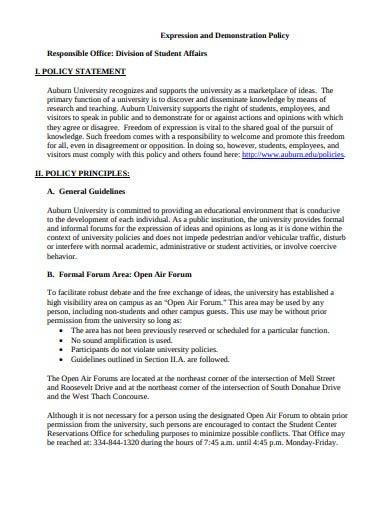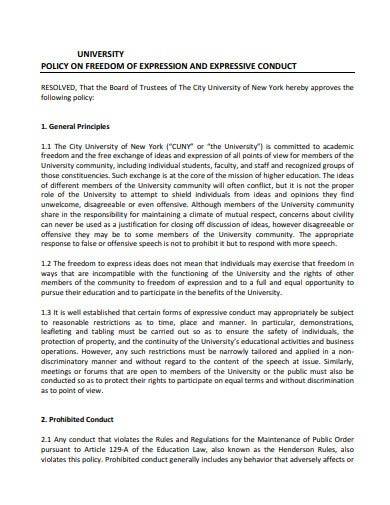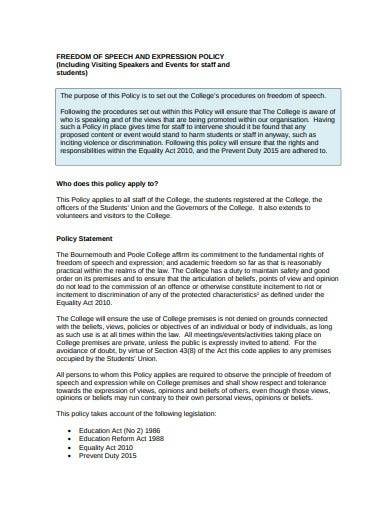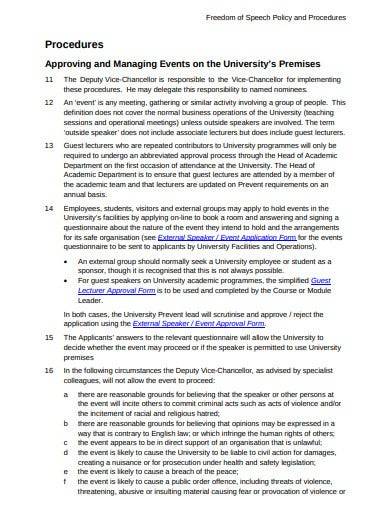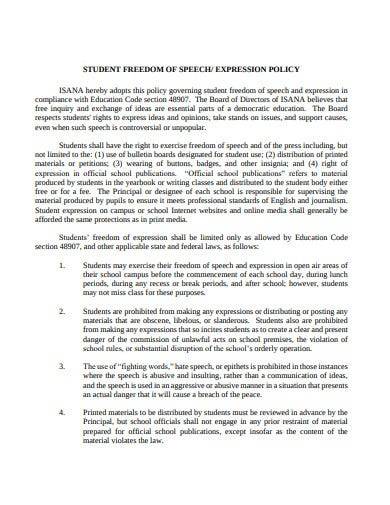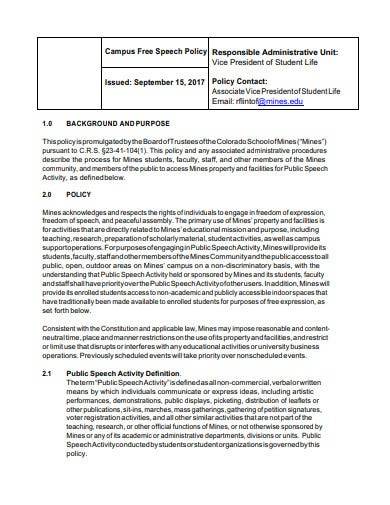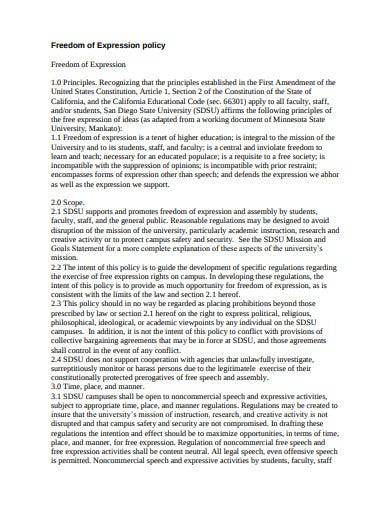Freedom of expression refers to the human right that allows people to express their opinion as well as to seek, take part, and receive information through various mediums. This right also encourages progressive conversations and provides a safe and secure environment or platform for critical voices. Freedom of expression ensures that every individual even students has the right to search, acquire, receive, and keep information about human rights and their violations.
FREE 10+ Student Freedom of Expression Policy Samples
1. Student Freedom of Expression Policy Template
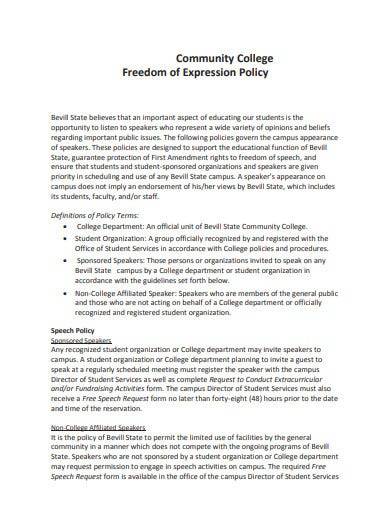
2. Sample Expression Demonstration Policy
3. Policy on Student Freedom of Expression
4. Freedom of Speech & Expression Policy
5. Freedom of Expression Policy Procedures
6. Student Freedom of Speech/Expression Policy
7. University Student Freedom of Expression Policy
8. Campus Free Freedom of Expression Policy
9. Free Speech Policy Template
10. Sample Freedom of Expression Policy
11. Simple Freedom of Expression Policy Template
What is the Student Freedom of Expression Policy?
Student freedom of expression policy refers to the students’ rights to express their beliefs and ideas in a manner they chose and provides protection to what they say, write, and how they express themselves. This policy also protects their capacity to meet people, protest, and organize. Other school policies that students, as well as teachers, must follow include student travel policies, homework policies, academic enrichment policies, bullying policies, safety policies, and more.
How to Promote Freedom of Expression Policy for Students
The freedom of expression policy for students protects their right to free expression of their ideas and opinions as well as the right to use their school’s bulletin boards, distribute printed materials, and wearing of badges and other types of insignia. However, the policy does not support any obscene and slanderous expressions in compliance with the current legal standards. It also prohibits riots or any violation of lawful community college rules and regulations or any major disruption of the orderly operations of the institution.
Step 1: Make Sure to Educate All Parties
Create a strategic action plan to educate the school staff, faculty, and students about the First Amendment, academic freedom, and the essence of promoting a diverse, inclusive, and equitable environment for all students. Distribute a statement that effectively explains the institution’s values which is the core of its academic mission statement.
Step 2: Express Support for Free Speech and the Faculty
Make sure to show that the institution supports free speech and defends the right of controversial speakers as they express their opinions while also supporting the human right to protest and counter-speech. The institution must also implement a system that supports the academic freedom of all administrators.
Step 3: Encourage Discussion Between Parties with Opposing Views
Let opportunities occur in which students, staff, and faculty with different and opposing views communicate and discuss complex concerns and issues. You can plan programs or activities to manage discussion while ensuring mutual respect and understanding.
Step 4: Provide the Essential Resources
Available resources can encourage the institution to commit to its support of free speech and inclusion. You can hire student-facing staff to provide the necessary resources and manage programs that align and address the concerns of the student body.
FAQs
What are the elements of the freedom of expression policy?
Freedom of expression policy includes elements such as the purpose of the policy, the definition of terms, the scope of work and authority, and the description of the policy like the assertion of freedom of speech, its limits, limits on protest, and challenge of freedom of expression, roles and responsibilities of the association, and complaints procedure. It also includes monitoring and reviewing, relevant legislation, and related documents and policies and procedures.
What are the other student rights and policies?
The other types of student rights and policies include academic integrity policy, instructional material policy, matriculation rights, sexual assault, sexual harassment policy, student code of conduct, and students’ privacy rights and privacy policy.
What is the scope of freedom of expression?
The freedom of expression policy provides protection to almost any way in which an individual can express themselves regardless of the tone and content. It covers all public and private spaces, purposes like political, commercial, and artistic, forms such as pictures, sounds, and words, and media like radio, cartoons, social media, films, and television.
Freedom of expression is an essential human right that allows and protects an individual’s ability to freely exchange and express their opinions, ideas, and information which also enables the rest of the society to create their own thoughts and opinions on different public concerns and issues. However, the government can restrict this law and punish expressions that cause harm to other individuals like violations of defamation, obscenity, public order, and more.
Related Posts
FREE 10+ School Recommendation Letter Samples in MS Word PDF
FREE 10+ Sample Letter of Intent For University in PDF MS Word ...
FREE 11+ Sample Feedback Forms in MS Word
FREE 10+ Sample Algebraic Multiplication Worksheet Templates in ...
FREE 41+ Sample Agenda Templates in PDF MS Word
FREE 7+ No Experience Resume Samples in MS Word PDF
FREE 7+ Sample Nursing Cover Letter Templates in PDF
FREE 9+ Sample Personal Statement Templates in Google Docs ...
FREE 14+ Progress Report Card Templates in MS Word PDF ...
FREE 7+ Sample Letter of Interest in MS Word PDF
FREE 23+ Sample Thank You Letter Templates in PDF MS Word ...
FREE 13+ Certificate Templates for Kids in PSD MS Word
FREE 7+ Sample Admiration Letter Templates in PDF MS Word
FREE 10+ Sample Confidentiality Statement Templates in PDF MS ...
FREE 4+ Sample Teaching Resignation Letter Templates in MS Word

